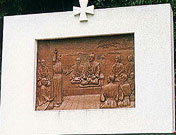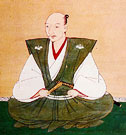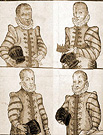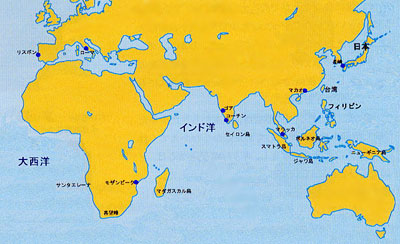- HOME |
- NEWS |
- HISTORY |
- CHURCH |
- WHO ARE WE?
"Laudate" English Page
History of the Japanese Catholic Church
2. Tensho Ken-o shisetsu (mission to Europe of 1582)
Mission of Father Tores
In 1551, after Francisco Xavier left, Father Tores who came to Japan with him became the second superior for the Christian propagation in Japan, and worked for the development of the church.
As Yoshinaga Otomo has been destroyed by Motonari Mori, Father Tores moved from Yamaguchi to Bungo, which was governed by Sorin Otomo, and made a center for the Japanese Christian Church. The first Japanese Jesuit Brother Lorenzo and another Jesuit, Luis de Armeida *1 , joined him in collaboration.

Father Armeida, who was medical doctor, offered all his fortune, and opened an orphanage and a hospital. Christian propagation of Father Tores extended from Kita Kyushu to Higo, as the power of Sorin became greater.
Sumitada Omura *2, feudal lord of Hizen, requested to open a commercial port in Yokoseuchi. However, the history of this port ended soon, and instead, the port of Nagasaki developed as an international port.
Father Tores, in his desire to realize the wish of Francisco Xavier, extended his mission work to Kansai, and gradually many Budhist monks visited him.
The well known Christian Daimyo Ukon Takayama *3, got baptized around this time.
Tores worked as Superior of the Japanese propagation for 18 years, and passed away in the church of Iki.
Seminario and Collegio

Francisco Cabral *4, who succeeded Tores, in 1570, started to visit Japanese churches immediately after he arrived to Japan. At that time, Japan was under the authority of Nobunaga Oda. As he showed favor for Christianity, propagation developed very well.
In 1575, they built the famous temple, Nanbandera, together with Organtino *5, Luis Frois *6, and Ukon Takayama and his son. In 1578, Sorin Otomo who had been protecting the mission, also got baptized by Cabral.
When Cabral became Tores' successor, the number of Catholics in Japan was approximately 30000, but it counted more than 100 000 at this period.
However, Cabral criticized the policy of adaptation to the Japanese culture. He showed a very strict attitude towards the Jesuits, and prevented them to study the Japanese language. Therefore, the emotional confrontation among the Jesuit members became deeper.
July 1579, the inspecting priest Alexandro Valignano *7 came to Japan, and when he saw the disunity of the Japanese churches, started the reform. (He was sent to the mission countries by the Superior General of the Society of Jesus, to inspect the situation and to take a measure whenever there is a problem.)
First measure he took was to solve the financial and organizational problem.
To ensure the income from commerce with Macao, promotion of the Japanese delegation, and to divide the Japanese diocese into three.
He also promoted the study of the Japanese language, culture and history, and to complete the education of the Japanese missionaries, started to build the Seminario (small college of theology) , Collegio (bigger college of theology) and the Noviciate.
First Seminario was built in 1580 in Arima, and then in Azuchi. Among the first students of Azuchi, was Paulo Miki *8, one of the Japanese 26 martyrs. Among the students of Arima, there was Sebastian Kimura, who was the first Japanese priest, and who died in martyrdom in Nishizaka, Nagasaki.
Cabral who was suspicious about the Japanese character had an argument with Valignano, about the mission policy, but he was dismissed of his post, and sent to Macao.
In promoting this reform, Valignano was hoping to have a Japanese bishop in the future, who will take care of financial and organizational situation of the church, independently. He also visited Nobunaga, and ensured the protection of the Christianity.
Tensho Ken-o shisetsu (mission to Europe of 1582)

delegation of four young enboys
In 1582, Valignano finished his first inspection in Japan, and before leaving, he thought of sending a delegation of young boys to Europe, and make them visit the Pope.
The purpose of the delegation is to show them the missionary achievement of the Society of Jesus in Europe, and to make them experience the Christian world in Europe. And then, they can share the highly evaluated experience with their companion in Japan.
Mansho Ito represented Sorin Otomo, and Miguel Chijiwa for Harunobu Arima and Junji Omura. Martino Hara and Julian Nakaura were chosen to be their assistants.
Delegates:
- Mansho Ito.
- Grandson of the feudal lord of Hyuga, Yoshisuke Ito.
He went to Macao to study theology, and was ordained priest in Nagasaki in 1608.
Died in Nagasaki in 1612. - Miguel Chijiwa.
- Grandson of Haruzumi Sengan Arima, and nephew of Junji Omura. Cousin of Harunobu Arima.
He left the Society of Jesus and served Yoshiaki Omura.
In 1606, when Yoshiaki left the religion, he followed him.
- Martino Hara.
- Born in Hasami, he was the follower of Omura.
He was very active in the Collegio of Nagasaki, and ordained priest in 1608 in Nagasaki.
And he worked in Kokura, Hyuga and Yamaguchi.
In 1614 he was sent in exile to Macao, and died in 1629. - Julian Nakaura.
- Born in Nishikaicho, he was also a follower of Omura.
He went to Macao to study theology and was ordained priest in 1608 in Nagasaki.
Pastoral work in Shimabara, Amakussa,
Hachishiro, Yanagawa and Kokura.
1632, he was caught in Kokura and suffered in Kurusu-cho prison.
1633, died as martyr in Nishinosaka.
Assistant delegates:

February 20, 1582, together with Valignano and other Jesuits, 10 people left the port of Nagasaki by ship. At that time, the danger of ship wreck was frequent, and they also had to wait for the appropriate wind, which made the journey stop for many months.
The youth delegation traveled through Macao, Malacca and to Goa. In Goa, as
Valignano has been named to become Provincial Superior, Nuno Rodriguez took the responsibility of the delegation. They went around the Cape Hope, and after 2 years and 6 months finally arrived to Portugal in August 1584.
At that time, Portugal was governed by a Spanish king. They first went to visit Cardinal Austoria, and went to Spain. From the time they visited King Felipe II in Madrid, people began to welcome them with enthusiasm.
March 23, 1585, on the day of their official visit to the Pope Gregorio XIII, they were wearing the Japanese kimono, and that made the people excited with surprise and delight. In the Imperial room of the Vatican Palace, the letter from the Christian feudal lord has been read, and they could talk with the Pope with interpretation. The Pope passed away only 16 days later.
The next Pope, Sixtut V, also treated them kindly and they became the honorary citizens of Rome. After the visit to the Pope, they got so many invitations , as many people wished to meet them. In April l586, the delegation left Europe, after going to northern Italy. Passing in India, they could meet Valignano once more in Goa.
Arriving in Macao, they heard the sad news of religious prohibition in Japan.
And because of this they stayed two years in Macao.
In June 1590, after 8 years, they finally could go back to Japan, with Valignano who went to Japan as an assistant delegate from India.
Annotation:
- *1 Luis de Armeida (1525~1583)
-
Born in a Jewish family in Lisbon, he studied medicine. He was a wealthy merchant, but getting to know the Society of Jesus in India, he came to Japan in 1552.
While being in Japan, he made his decision to offer his life as a Jesuit, and cooperated in charity activities by giving away his own personal property. In 1556, he entered the Society of Jesus.
He founded the first general hospital in Japan, and preached through medicine. People being healed of their illness wished to be baptized, and he was surrounded by the poor especially. Together with Tores, he preached in Goto Island, Amakusa and Arima.
In 1580 he was ordained priest in Macao. The following year he became the Superior of the Amakusa district, and died in Kawachiura.
- *2 Sumitada Omura (1533-1587)
-
He was territorial proprietor for the peninsula of Nishihisaka. Among the Portuguese who wished to open a port in his territory, he had a favor for the Christianism.
Baptized by Father Tores , he became the first Christian feudal lord. His baptism name was Bartoromeo. He destroyed the temples in his territory and tried to convert everyone into Christian. He also made Nagasaki as the church territory. All these caused the Bateren (priests) expulsion later.
- *3 Ukon Takayama (1533-1587)
-
Son of Hidanokami Takayama was baptized as child and his baptism name was Just. At the age of 21, he was given the position of the governor of Takaso.
He cooperated to the construction of Nanban temple, and he was a good example to those who were studying about the faith and made lectures in the church.
In 1587 all the priests were expelled (expulsion of Bateren) and he escaped to Awaji and Shodojima Island, but later worked for Toshiie Maeda. In 1612, Christianity has been prohibited, and ordered by Ieyasu Tokugawa, he was expelled to Manila. He has been one of the faithful disciples of Sen Rikyu, and got the name Minaminobo.
- *4 Francisco Cabral (1533-1609)
-
Born in Portugal,he went to India in 1550, and entered the Society of Jesus in 1556 in Goa. He was ordained priest in 1558.
In 1570, he came to Japan and became the chief preacher.
As he was criticizing the adaptation into Japanese customs, and that he wanted the European leadership, there was confrontation between Valignano.In 1580 he resigned his position of the head of propagation, and moved to Macao.
In 1592 he became the provincial superior of India, and passed away in Goa. - *5 Organtino (1533~1609)
-
Born in Brescia, Italy.
He entered the Society of Jesus in 1556, and desired the mission in the Orient.After being the Superior of the St. Paul Institute in India, came to Japan in 1570. He met Nobunaga Oda, who was kind to him, more than 10 times, and did missionary work in the region of Kyoto.
Due to Bateren expulsion he was escaping to Shodojima, and came back and forth to Kyoto area.
In 1604, he retired in Nagasaki where he stayed until his death. - *6 Luis Frois (1532~1597)
-
Born in Lisbon, Portugal.
In 1548 he entered the Society of Jesus and went to India.
In 1561 he was ordained priest in Goa. His talent has been estimated while working as secretary to the superior of the Institute and of the provincial superior.In 1563 he came to Japan and the following year got to Kyoto.
Nobunaga Oda was pleased with him and they met several times. He left much in the church history of Japan, and during the era of Azuchi Momoyama (1500~1600) he was much appreciated in his social, cultural and regional studies. He passed away in his convent in Nagasaki. - *7 Alexandro Valignano (1539~1605)
-
Born in Napoli, Italy in 1539, he studied law in Padova university in Venezia.
In 1603 he entered the Society of Jesus, and at a young age of 34, he became the inspector of Eastern India. Ordained priest in 1570.He visited Japan as Jesuit inspector three times. He founded financial, organizational and educational institution for the Japanese church, and later sent a delegation of Tensho youngsters to Rome. One of his educational deed was that he brought into Japan a printing machine, and taught how to use it.
He left Japan in 1603 for Macao where he passed away.
- *8 Paulo Miki (1563~1596)
-
Son of Handayu Miki, the Christian worrior.
He was among the first graduate of Collegio in Azuchi. He became the Jesuit Irmao (Portuguese) and was preaching in Osaka. He was caught there and dragged around Kyoto, and died as martyr in Nagasaki.
He is one of the 26 Japanese martyrs, and his ashes are at the memorial Institute of 26 martyrs.
Copyright (C) 2007-2009 Daughters of St.Paul, Japan. All Rights Reserved.